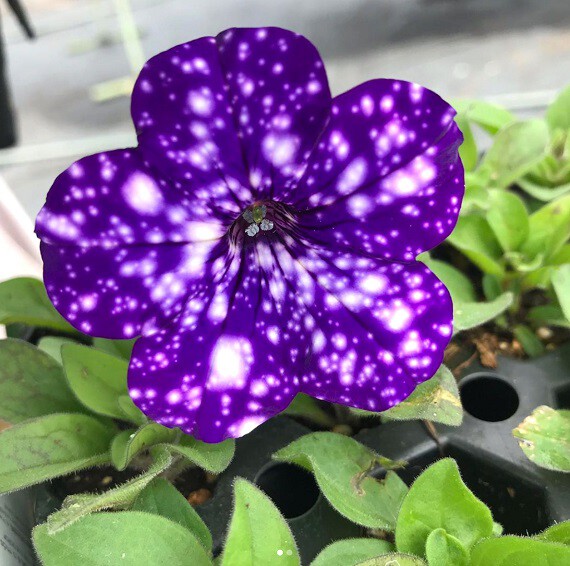Sure, petunias are easy-to-grow annuals, popular for adding long-lasting color to your garden or patio in the summer. But to me, they tend to blend into the background because I see them filling so many hanging baskets and containers at stores and garden centers. So I was quite surprised when I was looking through Instagram and saw a new-to-me variety called ‘Night Sky’ petunias. Their vivid purple petals speckled with white instantly stopped me mid-scroll on my phone screen. I couldn’t believe they were actually petunias at first, because they didn’t look like any other petunias I’d seen before in garden centers. Solid purple varieties exist of course, but the starry effect of the white spots on 'Night Sky' is completely mesmerizing.

Sometimes called galaxy flower because of how closely its appearance resembles the cosmos, ‘Night Sky’ petunia is a relatively new variety introduced in 2016. Since then, it's quickly gained popularity on Instagram, with nearly 4,000 posts tagged #nightskypetunia. People love how gazing at a single bloom up close is like admiring a constellation-spangled sky in the evening, but these unique petunias also lend some serious star power to containers or hanging baskets from afar. These blossoms are definitely not going to fade into any backgrounds!
Buy It: 4 'Night Sky' Petunia Plants, $22.95, Burpee
For a different effect, ‘Starry Sky Burgundy’ and ‘Pink Sky’ varieties are also available. Both have similar white speckles on their petals, but ‘Starry Sky Burgundy’ is deep red with a yellow starburst in the center, and ‘Pink Sky’ has cheery, hot pink blooms.
How to Grow ‘Night Sky’ Petunias
Petunias are annuals, so they last only growing season. Luckily, once they’re blooming, they’ll continue flowering for months until the first fall frost. ‘Night Sky’ petunias tend to start flowering in the summer, and continue through fall. Plant them in a spot with full sun, where they’ll get at least six hours of direct sunlight every day. Any less, and your plants could produce fewer flowers.
Petunias are drought-tolerant, but don’t like to be planted in soggy soil, so be sure to choose a well-drained spot if you grow them in your yard. If you plant them in a container or hanging basket, let the top of the soil get dry to the touch before watering them again (some planters could need watering every day).
Because they use a lot of energy to bloom almost constantly, petunias also need to be planted in rich soil with plenty of organic matter that will provide the nutrients they need. Fertilizing them regularly also will help the plant keep producing flowers; use a balanced 10-10-10 fertilizer every two weeks for containers, and every three weeks for petunias planted in the garden. They shouldn't need much deadheading because the spent flowers usually fall off on their own, but you can give it a light trim halfway through the season if the stems start getting too long.
The pattern on each ‘Night Sky’ flower can change with the temperature, so many of your blooms might transform as the growing season progresses. In general, cooler temperatures will yield more white spots and warmer temperatures will cause the petals to be more purple. Usually, you’ll see galaxy flowers swirled with the most “stars” in fall, as the weather starts cooling down.
If you want to start the seeds yourself, follow the instructions on the seed packet (usually they'll need to get growing by late February). It's becoming a little late for starting seeds this year, but it'll be time to get mature plants in the ground soon. Most growers will start shipping the plants in May, when many parts of the country have already had their final spring frost, so don't wait too long to get your order in. For most areas, mid-May and early June is the best time to plant these one-of-a-kind petunias in your garden.